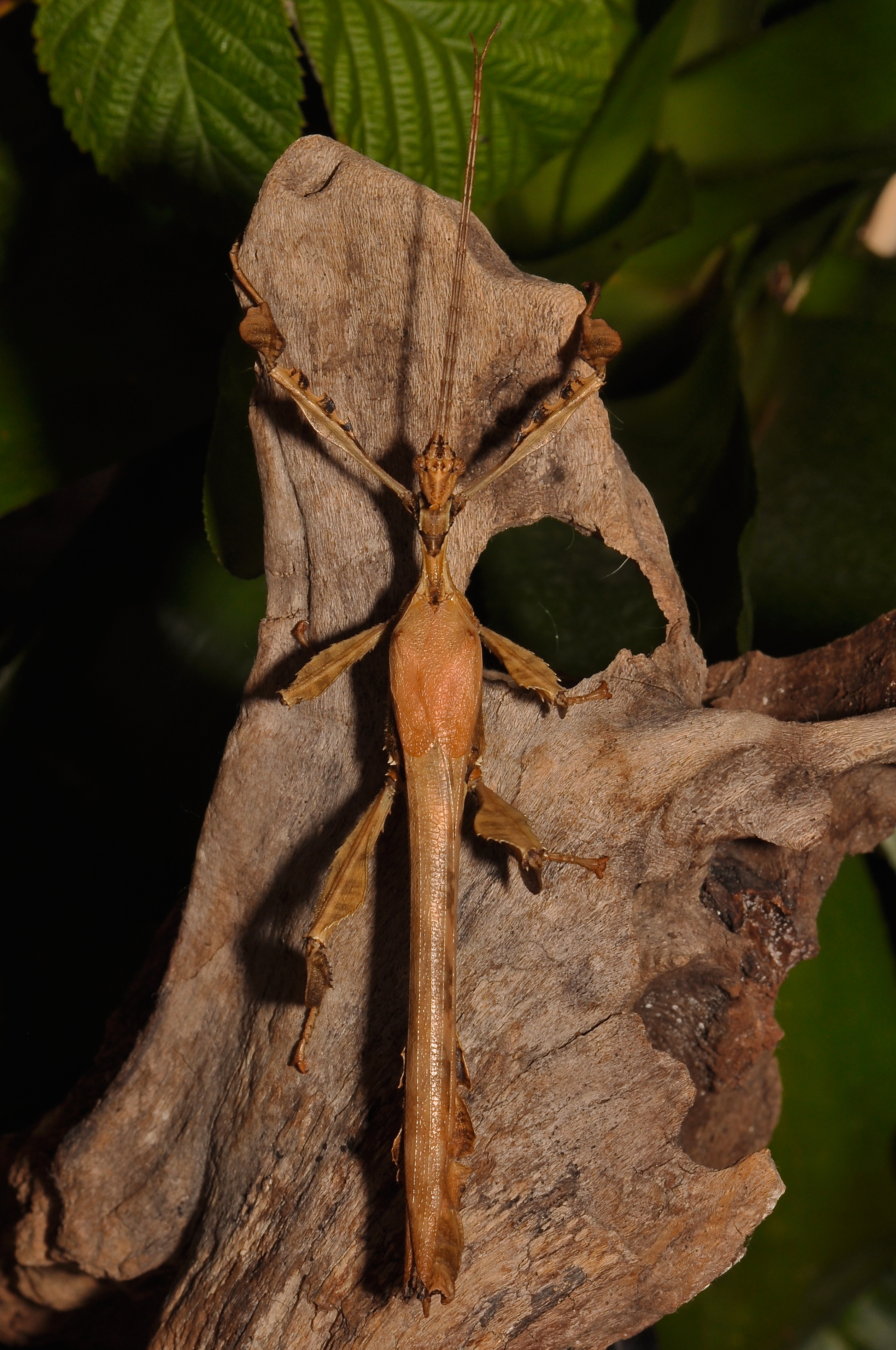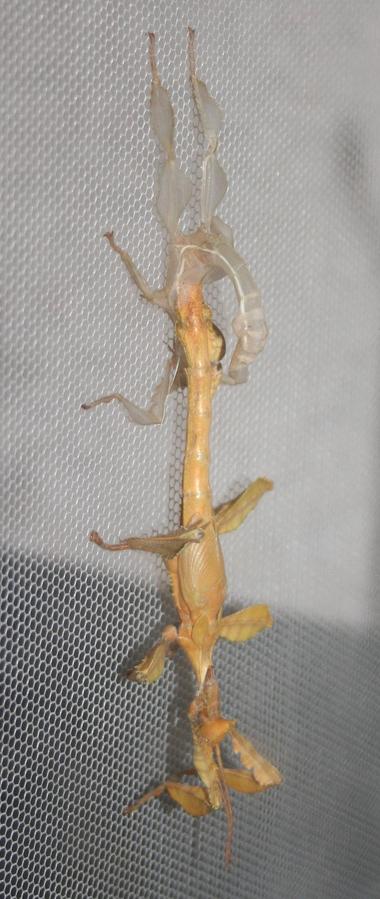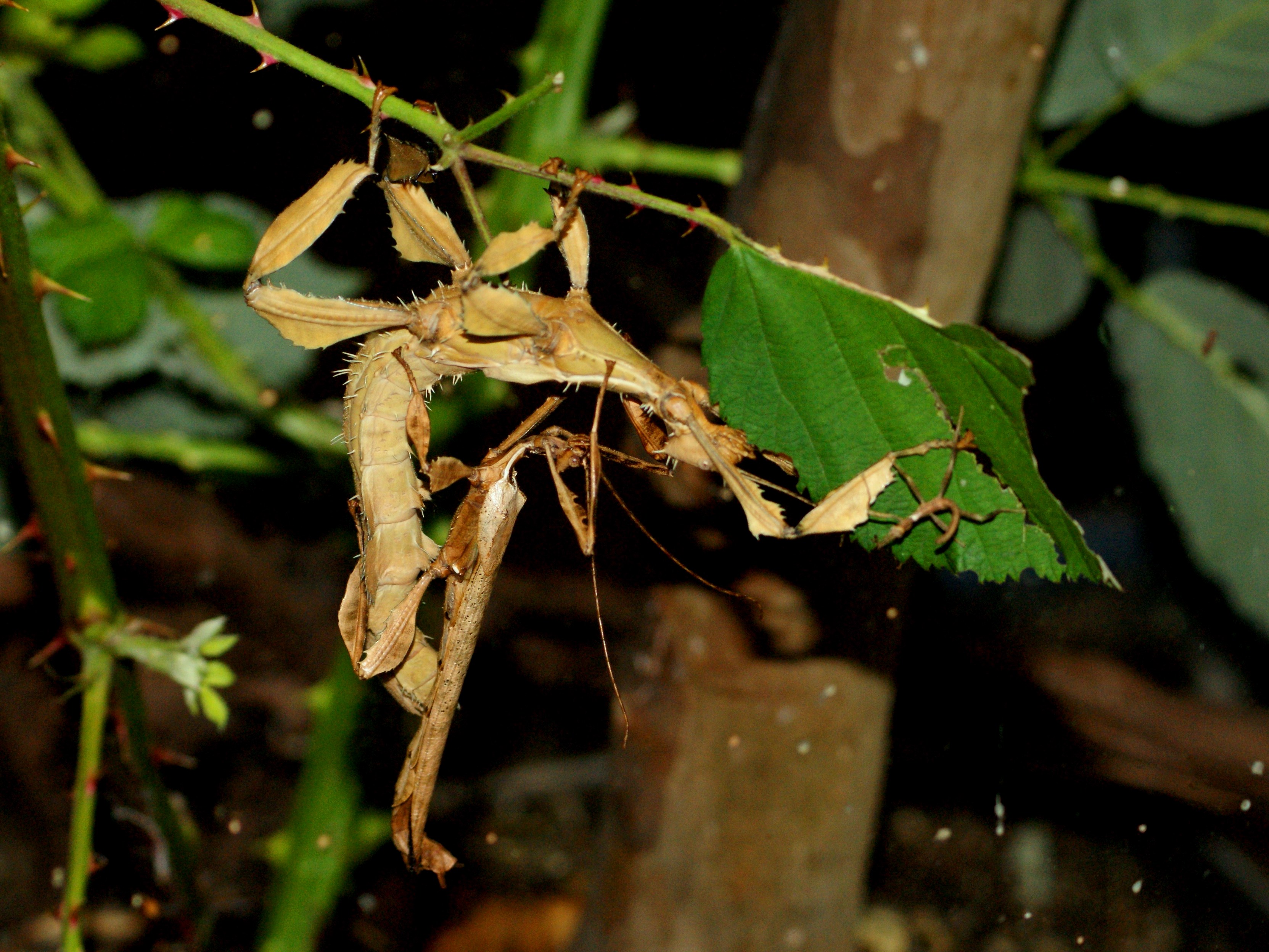Extatosoma tiaratum on:
[Wikipedia]
[Google]
[Amazon]
''Extatosoma tiaratum'', commonly known as the spiny leaf insect, the giant prickly stick insect, Macleay's spectre, or the Australian walking stick, is a large
 Female adult ''E. tiaratum'' are covered with
Female adult ''E. tiaratum'' are covered with


 This species is relatively common in captivity. It is used in
This species is relatively common in captivity. It is used in

Phasmid Study Group: ''Extatosoma tiaratum''
Retrieved 21 March 2021. {{DEFAULTSORT:Extatosoma Tiaratum Phasmatidae Insects of Australia Insects described in 1826
species
In biology, a species is the basic unit of classification and a taxonomic rank of an organism, as well as a unit of biodiversity. A species is often defined as the largest group of organisms in which any two individuals of the appropriat ...
of Australian stick insect endemic
Endemism is the state of a species being found in a single defined geographic location, such as an island, state, nation, country or other defined zone; organisms that are indigenous to a place are not endemic to it if they are also found else ...
to Australia
Australia, officially the Commonwealth of Australia, is a sovereign country comprising the mainland of the Australian continent, the island of Tasmania, and numerous smaller islands. With an area of , Australia is the largest country by ...
. The species has the Phasmid Study Group number PSG9.
Range
''E. tiaratum'' is native toQueensland
)
, nickname = Sunshine State
, image_map = Queensland in Australia.svg
, map_caption = Location of Queensland in Australia
, subdivision_type = Country
, subdivision_name = Australia
, established_title = Before federation
, establishe ...
and New South Wales
)
, nickname =
, image_map = New South Wales in Australia.svg
, map_caption = Location of New South Wales in AustraliaCoordinates:
, subdivision_type = Country
, subdivision_name = Australia
, established_title = Before federation
, es ...
but has extralimital distribution as far away as New Guinea
New Guinea (; Hiri Motu: ''Niu Gini''; id, Papua, or , historically ) is the world's second-largest island with an area of . Located in Oceania in the southwestern Pacific Ocean, the island is separated from Australia by the wide Torres ...
.
Description
 Female adult ''E. tiaratum'' are covered with
Female adult ''E. tiaratum'' are covered with thorn
Thorn(s) or The Thorn(s) may refer to:
Botany
* Thorns, spines, and prickles, sharp structures on plants
* ''Crataegus monogyna'', or common hawthorn, a plant species
Comics and literature
* Rose and Thorn, the two personalities of two DC Comic ...
-like spikes for defense and camouflage
Camouflage is the use of any combination of materials, coloration, or illumination for concealment, either by making animals or objects hard to see, or by disguising them as something else. Examples include the leopard's spotted coat, the b ...
. Their long, rounded bodies grow to about 20 cm long. The females are further described as "heavy-bodied, brachypterous and having numerous spines and integumental expansions on the face and legs, including a tuft of spines on the conical occiput of the hypognathous head". As mentioned, the wings of the female are too small for flying, especially when she is gravid
In biology and human medicine, gravidity and parity are the number of times a woman is or has been pregnant (gravidity) and carried the pregnancies to a viable gestational age (parity). These terms are usually coupled, sometimes with additional t ...
.
Exhibiting the sexual dimorphism of many similar insects (particularly other phasmids as well as mantises), males are small and thinner, growing only about 11 cm in length and have three ocelli. Males lack the thorny growths except for spikes around their faces. They have long wings and are good flyers who readily take to the air if disturbed or in search of females.
Anti-predator adaptations
Threat behaviour
Both sexes, when threatened, adopt a threat pose, standing on the front and middle legs, pointing theirabdomen
The abdomen (colloquially called the belly, tummy, midriff, tucky or stomach) is the part of the body between the thorax (chest) and pelvis, in humans and in other vertebrates. The abdomen is the front part of the abdominal segment of the to ...
up or to the side in a sort of " scorpion" pose. They fold back their legs to defend themselves if anything comes in contact with their abdomen; the pincer movement with the sharp spines on the rear legs can puncture human skin. Adults make clicking sounds and can release a defensive odor reminiscent of toffee. Males may attempt to startle predators by flashing their wings open.
Camouflage
''E. tiaratum'' makes use of both passive and activecamouflage
Camouflage is the use of any combination of materials, coloration, or illumination for concealment, either by making animals or objects hard to see, or by disguising them as something else. Examples include the leopard's spotted coat, the b ...
. It adopts a curved pose when it hangs inverted amongst foliage with "its highly procryptic abdomen curled over its back." Individual ''E. tiaratum'' vary in color and appear brown, mottled brown, green, reddish, cream, yellowish, or entirely white.
Like many stick insects, ''E. tiaratum'' actively sways back and forth or side to side when disturbed or when there is a gust of wind
Wind is the natural movement of air or other gases relative to a planet's surface. Winds occur on a range of scales, from thunderstorm flows lasting tens of minutes, to local breezes generated by heating of land surfaces and lasting a few ...
, with a frequency
Frequency is the number of occurrences of a repeating event per unit of time. It is also occasionally referred to as ''temporal frequency'' for clarity, and is distinct from ''angular frequency''. Frequency is measured in hertz (Hz) which is eq ...
distribution like foliage rustling in the wind. The swaying behaviour may be motion crypsis, preventing detection by predators, or motion masquerade, promoting misclassification (as something other than prey), or a combination of the two.
Mimicry
Newly hatched ''E. tiaratum'' nymphs are ant mimics and resemble the insects in whose nest they are born. Their aposematic pattern—orange head, white collar, the rest black—mimics the ant genus '' Leptomyrmex'' and makes them appear toxic. Although most adult stick insects are notoriously slow, these nymphs are speedy, active, and quickly make their way to the trees. Their locomotion slows when they moult into their second and subsequentinstar
An instar (, from the Latin '' īnstar'', "form", "likeness") is a developmental stage of arthropods, such as insects, between each moult (''ecdysis''), until sexual maturity is reached. Arthropods must shed the exoskeleton in order to grow or ...
s. Females acquire their distinctive spiky appearance through additional moults.
Reproduction
''E. tiaratum'' typically reproduce throughsexual reproduction
Sexual reproduction is a type of reproduction that involves a complex life cycle in which a gamete ( haploid reproductive cells, such as a sperm or egg cell) with a single set of chromosomes combines with another gamete to produce a zygote th ...
and produce eggs that hatch four months later. When no males are present in the population, this stick insect exhibits parthenogenesis
Parthenogenesis (; from the Greek grc, παρθένος, translit=parthénos, lit=virgin, label=none + grc, γένεσις, translit=génesis, lit=creation, label=none) is a natural form of asexual reproduction in which growth and developmen ...
instead. Eggs laid without fertilization
Fertilisation or fertilization (see spelling differences), also known as generative fertilisation, syngamy and impregnation, is the fusion of gametes to give rise to a new individual organism or offspring and initiate its development. Pro ...
take up to nine months to hatch and produce only females. In either cases, the female "flicks" her eggs, swinging her tail, up to several feet to land on the forest floor. These eggs must be kept relatively cool - under 25 °C - or they are unlikely to hatch.
The outside material of ''E. tiaratum'' eggs consists of lipid
Lipids are a broad group of naturally-occurring molecules which includes fats, waxes, sterols, fat-soluble vitamins (such as vitamins A, D, E and K), monoglycerides, diglycerides, phospholipids, and others. The functions of lipids in ...
s and other organic compound
In chemistry, organic compounds are generally any chemical compounds that contain carbon-hydrogen or carbon-carbon bonds. Due to carbon's ability to catenate (form chains with other carbon atoms), millions of organic compounds are known. Th ...
s that ants identify as food. They carry these eggs to their colony
In modern parlance, a colony is a territory subject to a form of foreign rule. Though dominated by the foreign colonizers, colonies remain separate from the administration of the original country of the colonizers, the '' metropolitan state' ...
, consume the edible outer portion, and dump the intact eggs into their waste piles. Luckily for captive breeding, the ants eating the edible outer layer is not crucial to development, so they will hatch just as healthy without the need for any removal of the outer layer, which is not easily visible.

Cultivation
 This species is relatively common in captivity. It is used in
This species is relatively common in captivity. It is used in laboratories
A laboratory (; ; colloquially lab) is a facility that provides controlled conditions in which scientific or technological research, experiments, and measurement may be performed. Laboratory services are provided in a variety of settings: physi ...
, kept for projects in schools (as is ''Carausius morosus
''Carausius morosus'' (the 'common', 'Indian' or 'laboratory' stick insect) is a species of Phasmatodea (phasmid) often kept as pets by schools and individuals. Culture stocks originate from a collection from Tamil Nadu, India. Like the majorit ...
''), and is a popular pet among breeders of exotic insects in North America and Europe. One breeder advises specifically "For a stick insect with body length 127mm, to keep 2 adult females, you need a cage at least 600mm high, 300mm deep and 300mm wide."
Although the gestation period of their eggs is several months long, they are prolific breeders. A breeder notes that because of this insect's habit
A habit (or wont as a humorous and formal term) is a routine of behavior that is repeated regularly and tends to occur subconsciously.
of flicking its eggs, one can "hear them clicking against the glass" of their terraria. Some breeders in the United Kingdom
The United Kingdom of Great Britain and Northern Ireland, commonly known as the United Kingdom (UK) or Britain, is a country in Europe, off the north-western coast of the continental mainland. It comprises England, Scotland, Wales and ...
, concerned with the negative effects of inbreeding
Inbreeding is the production of offspring from the mating or breeding of individuals or organisms that are closely related genetically. By analogy, the term is used in human reproduction, but more commonly refers to the genetic disorders a ...
on the vitality of their stock, have introduced new gene
In biology, the word gene (from , ; "...Wilhelm Johannsen coined the word gene to describe the Mendelian units of heredity..." meaning ''generation'' or ''birth'' or ''gender'') can have several different meanings. The Mendelian gene is a b ...
s from abroad.
Females live to about 18 months old, males to only 6–8 months.
Diet
''E. tiaratum'' are herbivores and although they thrive on ''Eucalyptus
''Eucalyptus'' () is a genus of over seven hundred species of flowering trees, shrubs or mallees in the myrtle family, Myrtaceae. Along with several other genera in the tribe Eucalypteae, including '' Corymbia'', they are commonly known as ...
'' which is their native food, breeders abroad recommend feeding them bayberry
''Myrica'' is a genus of about 35–50 species of small trees and shrubs in the family Myricaceae, order Fagales. The genus has a wide distribution, including Africa, Asia, Europe, North America and South America, and missing only from Aust ...
, bramble, hawthorn
Hawthorn or Hawthorns may refer to:
Plants
* '' Crataegus'' (hawthorn), a large genus of shrubs and trees in the family Rosaceae
* ''Rhaphiolepis'' (hawthorn), a genus of about 15 species of evergreen shrubs and small trees in the family Rosace ...
, hazel, oak, photinia, raspberry, rose
A rose is either a woody perennial flowering plant of the genus ''Rosa'' (), in the family Rosaceae (), or the flower it bears. There are over three hundred species and tens of thousands of cultivars. They form a group of plants that can be ...
, and salmon berry
''Rubus spectabilis'', the salmonberry, is a species of bramble in the rose family Rosaceae, native to the west coast of North America from west-central Alaska to California, inland as far as Idaho. Like many other species in the genus ''Rubus ...
(red or yellow) and guava.
Although they survive well on non-eucalypt leaves, they don't always grow as large or retain the same natural colour.
Defense
''E. tiaratum'' are incapable of bites and stings and rely solely on passive defense and camouflage. Some predators (such as mantids) have good vision, and can see the most camouflaged animals. When threatened, spiny leaf insects assume an aggressive posture such as rearing up. Females have a tough, spiky exoskeleton while males are winged and can fly away from danger. All adults have glands under that spray a colorless toffee-like odor which is pleasant to humans, but deters most predators.
References
External links
Phasmid Study Group: ''Extatosoma tiaratum''
Retrieved 21 March 2021. {{DEFAULTSORT:Extatosoma Tiaratum Phasmatidae Insects of Australia Insects described in 1826